TWIN CITIES TRACTION
The Street Railways of
Urbana and Champaign, Illinois
Chapter 11
Routes Within the Cities
H. George Friedman, Jr.
Copyright © 2001 H. George Friedman, Jr. All rights
reserved.
This chapter will show the routes taken by the city and interurban lines
within Urbana and Champaign. They will be discussed roughly in chronological
order. Modern street and park names, where different, are in parentheses.
The routes have been numbered by the author, simply for convenience; these
numbers were not used by the system.
This chapter has two parts:
Part A. City Lines (immediately below)
Part B. Interurban
Routes Within the Twin Cities
Track maps are given at the end of the chapter.
A. City Lines
1. Horsecar Route
This route had no explicit name. It was simply the (only) route of
the Urbana Railroad Co., and later of the Urbana and Champaign Horse Railway
Co. From the Doane House in Champaign, via private right-of-way parallel
to the Illinois Central tracks, curving at 2nd South St. (Logan), across
Boneyard Creek just northwest of the corner of 2nd St. and Springfield,
curving across 3rd St. to a line parallel to and about 200 feet south of
Springfield, continuing in a straight line into West Main St. in Urbana.
At Main and Market (Broadway), the track curved to the south side of Main
Street next to the sidewalk, and the route ended in front of the Champaign
County Court House. Cars appear to have been double end, so that
the return trip was made over the same route without turning around.
At the point at which this route crossed the Boneyard Creek, just northeast
of the present intersection of Springfield Ave. and 2nd St., there was
a small stone arch bridge, probably built in 1860 or 1863, to carry the
horsecars across the creek. Even after the effective abandonment
of this part of the horsecar route, the little bridge remained. By
the 1970s, it was crumbling, and was rebuilt by volunteer stonemason
labor. The area around it was made into a small park in the Champaign Park
District system. In 2010, this little park was incorporated into a
landscaped flood control basin, and the bridge became a showpiece there.
See the photos at the end of Chapter 2.
2. The Electrified Main Line
Once electrification was completed, the still-unnamed single route of the
streetcars started at Hill and Neil Streets in Champaign, via Neil, Main,
Walnut, 1st South St. (Chester), University, Wright, Green (into Urbana),
Goodwin, private right-of-way, Main, to the Wabash Railroad crossing on
East Main St. Return via the same route. About August 1, 1891,
this was extended on the northwest end from Hill and Neil to the new power
house and car barn at Tremont St.
3. Fair Ground Branch
At first (July 1891), this started at 4th and John Streets in Champaign,
running to a connection with the Main Line at Wright and Green. It
may have operated as a shuttle, or at least part of the time as a through
route over the Main Line to Champaign and/or Urbana. In 1892, after
construction of several extensions, it operated from the power house in
Champaign via Tremont, Neil, Main, Walnut, 1st South St. (Chester), University,
3rd St., John, Wright, Green (into Urbana), Goodwin, private right-of-way,
Main, to the Wabash crossing on East Main St. In other words, it
was the same as the Main Line, except operating via 3rd St. and John instead
of all the way via University and Wright. From time to time in the
early 1900s, it was operated instead as a shuttle from Neil and Main in
Champaign to Wright and Green or Wright and John.
4. Church or New, and John or Wright
After completion of the Church and New Street extensions in 1892, both
the Main Line and the Fair Ground Branch were extended west to the two
new termini, and the track on Neil St. was used mostly for car barn access.
Typical routes combined the two western termini and the two intermediate
routes, resulting in four possible routes. These eventually became
identified on route signs as Church and John, New and John, Church and
Wright, and New and Wright.
The Church Street route began in Champaign on Church Street about 1/4
mile east of Arthur Road (Mattis Ave.), i.e. about four blocks west of
West End Park (Eisner Park), and went straight east on Church to Neil Street.
The New Street route began in Champaign at Prospect and Green, via Green,
New, Church, to Neil. Both routes then continued east via Main, Walnut,
1st South (Chester), University, to 3rd Street. At this point, the
Wright St. branch continued east via University and Wright to Green Street;
the John St. branch operated via 3rd Street and John to Wright, then to
Green. Both routes then continued into Urbana via Green, Goodwin,
private right-of-way, Main, to the Wabash crossing.
From time to time, the New Street branch was operated instead as a shuttle,
from Prospect and Green to New and Church, with passengers transferring
to the Church Street cars.
Beginning around 1900, some cars terminated on the east in Urbana at
Main and Market (Broadway), rather than at the Wabash crossing on East
Main.
In 1907, track was built on Neil Street between University and Church/Main.
There were curves connecting northbound cars from Neil east into Main, and
connecting southbound cars from Neil east into Main and west into Church.
There was initially no curve connecting northbound cars from Neil west into Church.
Northbound cars had to cross Church/Main to the north side of the intersection,
then reverse direction and cross southbound to turn west into Church Street.
This problem was solved in August 1912, when the fourth curve was added to the
intersection, allowing northbound cars to turn directly west into Church.
Cars operated in one direction via Neil, in the other via Main and Walnut.
Initially, Neil St. was used west and northbound, and Main and Walnut east
and southbound. Eventually, the directions were reversed, probably
in 1914.
Beginning July 1, 1909, the Green and Goodwin tracks were removed.
From that date, all cars operated from Wright Street east via the private
right-of-way. Also beginning on that date, the Wright Street branch
was combined with the Oregon Street Line (see #7, below).
5. Lake Shore Line
This line was inaugurated August 17, 1905. It operated in Urbana
from the Chautauqua grounds (part of the present Crystal Lake Park) via
Coler, First (Park), Market (Broadway), to Main Street. Return was
via the same route. Within a few weeks, it had been extended on the
east via Main Street to the Wabash Railroad crossing, and on the northwest
to the entrance of the then-new Fair Ground at Fairview Street. Service
north of Main and Market was sometimes discontinued in the winter.
In 1909, the track on Coler Street was extended north to the gate of Woodlawn
Cemetery. For a few years (at least 1909-1911), Sunday-only summertime
through service was operated to the Cemetery from downtown Champaign via
the John Street branch to Main and Market (Broadway) in Urbana, then via
the Lake Shore Line to Woodlawn.
In 1920, summer service on the Lake Shore Line itself was extended north
to Woodlawn.
The company also offered charter funeral service to Woodlawn Cemetery.
| Picture 11A-1. |
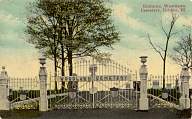
|
The gate of Woodlawn Cemetery. The streetcar track came up to
this point. For a funeral, the casket could ride to the end of the
track, then it would be transferred to a four-wheel cart and rolled to the
grave site. The family could share the streetcar with the casket, and other
mourners could ride on additional chartered streetcars, as necessary. |
6. Neil Street Line
This line was established in January 1907, primarily to offer local service
over the ITS interurban line to the west. It ran from the Wabash
RR crossing of N. Neil St. via Neil and John, initially to Lynn Street.
Later, it was extended from time to time, eventually extending as far as
Russell Street.
In 1922, with the establishment of the IC Shops Line (#14), that line
took over the segment on Neil north of Church/Main. The Neil Street
Line then terminated on the north at Neil and Main.
7. Oregon Street Line
This line was established when the company and the University agreed to
build a track across the UI quad in return for removal of the track on
Green and Goodwin Streets. The track crossed the quad about where
a bicycle path is today, from Daniel Street in Champaign to California
Street in Urbana. The new line served a part of Urbana which had
not previously had streetcar service. It is curious that it was named
for Oregon Street, because it ran for only three blocks on that street;
it ran for eight blocks on parallel California Street.
The new line was designed to run from downtown Champaign to downtown
Urbana. Early in its life, the company experimented with which of
the two possible Champaign routes (via Third and John or via University
and Wright) would be linked to the new track in Urbana. Eventually,
the University and Wright branch was combined with the Oregon Street route.
Beginning July 1, 1909, the new Oregon Street Line operated over this
route: from Neil and Main in Champaign, via Main, Walnut, 1st South (Chester),
University, Wright, across the UI campus into Urbana, Mathews, Oregon,
Lincoln, California, Market (Broadway), to Main Street. Return was
via the same route, except in downtown Champaign operating via University
and Neil to Main Street. The track on Mathews, which included a passing
siding, was at least partly on the west side of the street. (Around
1914, the direction of the loop in downtown Champaign was reversed.)
On January 1, 1921, the route combinations were changed. Beginning
that date, the Oregon Street Line operated from Main and Neil in Champaign,
via Neil, University, 3rd St., John, Wright, across the UI campus into
Urbana, Mathews, Oregon, Lincoln, California, Market (Broadway), to Main
Street. Return was via the same route, except in downtown Champaign
operating via University, Chester, Walnut, Main, to Neil. The Wright
Street branch was at this time set up as a separate route; see #13, below.
8. Owl Route
On March 11, 1907, an Owl Service was established to provide hourly overnight
streetcar service. It ran from Neil and Main in Champaign via the
Wright Street branch to Main and Market (Broadway) in Urbana, and return.
This does not seem to have been successful, and it was discontinued after only
a ten-day trial.
A more successful attempt at Owl Service was started July 20, 1911.
It used a loop route that covered the main daytime car lines. From
Prospect and Green in Champaign, it operated via Green, New, Church, Main,
Walnut, 1st South (Chester), University, 3rd St., John, Wright, across
the UI campus into Urbana, Mathews, Oregon, Lincoln, California, Market
(Broadway), Main, to the Wabash crossing on East Main. The return
trip was via Main, private right-of-way, Wright, John (into Champaign),
3rd, University, Neil, Church, New, Green, to Prospect.
At least by June 6, 1920, this had been cut back to run only from downtown
Champaign to downtown Urbana. The route was from Main and Neil in
Champaign, via Neil, University, 3rd St., John, Wright, across the UI campus
into Urbana, Mathews, Oregon, Lincoln, California, Market (Broadway), to
Main, returning via Main, private right-of-way, Wright, John (into Champaign),
3rd, University, Chester, Walnut, Main, to Neil.
9. Limited Service; later Short Line
On May 1, 1915, the other services between downtown Champaign and downtown
Urbana were supplemented by a Limited Service running from Main and Neil
in Champaign, via Neil, University, 3rd St., private right-of-way into
Urbana, Main, to Market (Broadway). Return was via the same route,
except in downtown Champaign via University, Chester, Walnut, Main, to
Neil.
This service lasted only a month or so in 1915, but was revived on September
6, 1919. It was renamed the Short Line on December 1, 1919.
This was destined to be the last streetcar line in the community, ending
service on November 10, 1936.
10. Church Street Line
On June 6, 1920, the company began to experiment with rearrangements of
the services along the Main Line. For the time being, the Oregon
Street Line (#7) and the Short Line (#9) were left unchanged, but the
other Main Line services were replaced by a Church Street Line, an Urbana
& Champaign via John Street Line (#11), and a John Street to the University
of Illinois Line (#12).
The Church Street Line operated along Church Street from Neil west to
the end of the track.
In the late 1920s [1927?], the tracks on Church Street were completely
rebuilt. The company did a very good job, and the street was repaved
with concrete at the same time. Some passing sidings were relocated
for maximum efficiency. Unfortunately, the concrete proved to be
a sounding board, and the new track, while admirable in all other ways,
was so noisy that the people living on the street complained vociferously.
As a result, the Church Street Line was converted to bus in [1928? 1929?].
Ironically, the track lasted until the late 1960s before the city finally
covered it with asphalt. Most of the rails remain under the asphalt
to this day.
11. Urbana & Champaign via John Street
This route was begun on June 6, 1920. See Church Street (#10).
The route operated from Main and Neil in Champaign via Neil, University,
3rd St., John, Wright, private right-of-way into Urbana, Main, to Market
(Broadway). Return was via the same route, except in downtown Champaign,
via University, Chester, Walnut, Main, to Neil.
This route was discontinued in about one month.
12. John Street to the University of Illinois
This route was begun on June 6, 1920. See Church Street (#10).
The route operated from Main and Neil in Champaign via Neil, University,
3rd St., John, to Wright. Return was via John, 3rd St., University,
Chester, Walnut, Main, to Neil.
After discontinuance of the Urbana & Champaign via John Street Line
(#11) on July 1, 1920, this was the only service along John Street until
the Oregon Street route took over John Street on January 1, 1921.
The John Street to the University of Illinois Line was then discontinued.
13. Wright Street Line
This was established January 1, 1921 when the Oregon Street Line in Urbana
was combined with the John Street branch in Champaign, and dropped the
Wright Street branch. The route was from Neil and Main in Champaign,
via Neil, University, Wright, to John Street. Return was via Wright,
University, Chester, Walnut, Main, to Neil.
14. Illinois Central Shops Line
The story of the establishment of this line is told in Chapter 7 [which
hasn't been written yet]. Here, let it suffice to record
that service began September 1, 1922 over the following route: from Church
and Neil Streets in Champaign, via Neil, Tremont St., and through the car
barn trackage onto IC right-of-way using the “sugar house” track, then
on the west side of the IC main line right-of-way to the shops complex
north of the city. Return was via the same route.
This service was subsidized by the Illinois Central (see Chapter 7).
The subsidy was withdrawn June 1, 1931. As a result, buses were substituted
May 18, 1932, and discontinued June 15, 1932.
This was the last city car line to be built, and the next-to-last to
be closed.
Note
Clearly, this chapter is unfinished. Research remains to be done
into the last ten or so years of operation of the routes above. What
can be said at this time is that, by the end of the 1920s, the Wright Street
and the Oregon Street Lines were gone. After the IC Shops Line closed
in 1932, only the Short Line remained until Champaign-Urbana City Lines
took over in 1936.
B. Interurban Routes Within the Twin Cities
1. ITS Champaign to Danville Line
The initial line of the Danville, Urbana & Champaign, beginning November
27, 1902, ran only from downtown Urbana to Danville. It had a siding
at the sidewalk, in front of the Champaign County Court House, connected
at both ends to the Main Street track in the center of the street.
The route was simply down East Main Street, turning onto the south side
of the road east of Glover Avenue. At the point at which Main Street
jogs over and connects to University Avenue (present day U. S. 150), the
track also jogged into a line parallel to, and south of, the track of the
Peoria & Eastern Railroad. Westbound trips used the same route.
| Picture 11B-1. |
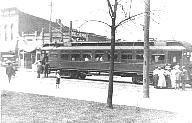
|
About 1909, one of the 300-308 series ITS cars loads passengers
on the siding in front of the court house on Main Street in Urbana.
The car had been chartered for a Sunday school class trip to Homer Park.
Looks like the lad in the foreground isn't going along. — Urbana Free
Library Archives |
Beginning September 6, 1903, the route was extended to downtown Champaign.
It used the same route as the Wright Street branch of the main city car
line (see Part A, line #4 above) to downtown Urbana. Almost immediately,
a terminal was built in Champaign on Walnut Street north of Main, with
a wye at the intersection and a stub track north of Main Street.
This opened September 19. An old city car was spotted at the end
of the stub as a temporary shelter until terminal space could be prepared
in the McKinley brokerage offices on Walnut Street.
| Picture 11B-2. |

|
This view, postmarked 1911, is west along Main Street in Champaign.
The cross street in the foreground is Walnut. The track to the north
(right) leads to the depot. There is a full wye in the intersection.
The interurban car approaching us on Main Street will probably turn south
(to our left) and back across the intersection into the stub terminal.
The street railway and interurban offices and the interurban depot shared
space in the business office of J. B. & W. B. McKinley since the DU&C
began interurban service between Champaign and Danville in 1903. —
C. U. Williams Photoette |
| Picture 11B-3. |

|
This view, dated December 24, 1909, is east on Main Street in Champaign
looking toward Walnut, where an ITS interurban car is crossing Main
through the Christmas Eve snow. The car is either heading into,
or backing out of, the depot siding. |
Up to this time, the private right-of-way west of Goodwin Avenue in
Urbana had been all but abandoned. In 1903, it was rebuilt for use
of the interurbans between Wright and Goodwin, use beginning December 10,
1903.
When the line to Decatur was built in 1907, track was laid on Neil Street
south from Church/Main. Beginning February 21, 1907, the westbound
interurbans from Danville were operated over University to Neil, Main,
to Walnut.
In 1909, the private right-of-way between 3rd Street and Wright was
also rebuilt for interurban use. Beginning about July 1, interurbans
operated via University to 3rd St. to the private right-of-way, then east
to downtown Urbana.
In 1913, a new station was built in Champaign on University Avenue east
of Walnut Street, and the wye and stub track on Walnut north of Main were
removed. Sidings were built onto the station property between the
station building and the Inman Hotel, the neighbor building on the west.
From January 12, 1914, local cars bound for Danville originated on one
of these sidings; limited through cars from the west stopped in the street
in front of the station. Westbound local cars from Danville would
wye in front of the station and back into a siding. Beginning March
4, 1914, westbound local cars looped through downtown Champaign via University,
1st South (Chester), Walnut, Main, Neil, University, to the station.
| Pictures 11B-4 and 11B-5. |

|
These two postcards show the ITS depot and its next-door
neighbor, the Inman Hotel, on University Ave. in Champaign between Walnut
and Market Streets. Both pictures show the alley between the buildings,
which had sidings for local interurban cars. The lack of shadows in the upper
picture suggests that the Inman Hotel had not yet been built, so this is a very early
view of the depot. In the alley to our right (the west side of the depot),
we see a self-propelled freight car. The lower picture shows a local car
in the alley, waiting for passengers to board. The depot was constructed
in 1913 on the site of an old mill. For the preceding several years, ITS
had used the site as a freight depot. — C. T. Photochrom (upper) |

|
| Pictures 11B-6 and 11B-7. |
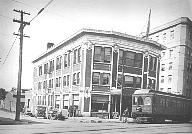
|
These two views were taken in June 1921. There
were two tracks in University Ave. at this point: a through track in the
center of the street, and a depot siding to the south of that track, on
which the cars in these pictures are standing. In addition, there
were the sidings in the alley between the depot and the Inman Hotel.
Note the electric light “flag” on the roof of the depot. — Illinois
Power Co. Archives |
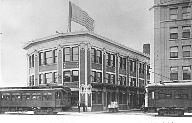
|
About 1927, the Wabash Railroad tracks were electrified from the Wabash
depot between Neil and Randolph Streets, east to the crossing of East Main
Street in Urbana. This was known as the Champaign Belt.
It permitted freight traffic to bypass the city streets in Champaign and
most of Urbana.
When the city car lines were abandoned on November 11, 1936, the City
of Champaign was eager to remove the tracks, but they were still needed
by the interurban cars. In 1937, passenger traffic was changed to use
the Champaign Belt, i.e., the electrified Wabash tracks,
from the Wabash depot between Neil and Randolph Streets, east
to the crossing of East Main Street in Urbana. This became the Danville
route until the end of service in 1953. The station on University
Ave. was abandoned (although it remained as offices for Illinois Power
and Light Co.), as was all street trackage in Champaign. The tracks
east of Wright Street on the private right-of-way were retained for coal
delivery to the University of Illinois and for passenger specials to campus
(e.g., football games), with trains backing in from Urbana.
| Picture 11B-7.5. |
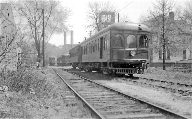
|
This undated photo, probably from the 1940s, shows several interurban
trains on the private right-of-way waiting to collect their passengers, probably
at the conclusion of a football game. The nearest car is reported to be
car 264.
|
2. ITS Champaign to Decatur Line
The Champaign to Decatur line opened about February 1, 1907. The
westbound line originated at the stub terminal at Main and Walnut Streets
in Champaign, operating via Walnut, University, Neil, John, and into a
right-of-way of John Street extended, with two sweeping curves taking it
northwest to a line parallel to and immediately south of Springfield Avenue.
It crossed Duncan Road at about the same point that the east-west Illinois
Central line crossed Springfield. Eastbound interurban cars operated
over the same route, except that they stayed on Neil Street all the way
to Main, then followed Main to Walnut.
Beginning January 12, 1914, the new Champaign station was put into service.
(See discussion under Danville line, #1 above.) Westbound local cars
originated on a siding next to the station, and limited through cars in
the street in front. They then operated over University to Neil and
turned south, using the same route as before. Eastbound cars from
Decatur operated north on Neil to University, then turned east to the station,
with local cars wyeing and backing into a siding.
From September 3 through November 7, 1914, while repairs were being
made on S. Neil St., a detour was required. Cars on the Decatur interurban
line were routed through downtown Champaign and west out Church Street,
down New to Green, and over a temporary track on New from Green to John,
where connection was made to the permanent track on John Street.
This is the only instance known of interurban cars operating on the Church
and New Street lines in Champaign.
About 1927, the Illinois Central tracks were electrified from a connection to
the interurban west of Duncan Road, east to the Wabash tracks at about State
Street in Champaign (the Champaign Belt line). The Decatur line was then
changed to use these tracks eastbound to Neil Street, then via Neil to
University to the station. Westbound cars operated from the station
via University, Walnut, Main, Neil, to the Wabash tracks. On August
1, 1937, when the Danville line was moved from city streets to the Wabash
tracks, the University Avenue station was abandoned as a station in favor
of the Wabash station, and cars operated through on the Illinois Central
and Wabash tracks, bypassing downtown Champaign. This was the route
to the end of service in 1955.
| Pictures 11B-8 and 11B-9. |

|
IT no. 271, one of the longest cars on the roster, turns
from Main Street in Champaign into Neil on its way to the electrified Wabash
and Illinois Central tracks which will start it west on its way to Decatur.
The date is 1936, toward the end of all street running in Champaign.
Note the partially completed new city building in the background, and in
the lower picture, the early model traffic light governing the intersection.
— University of Illinois Library Archives, News-Gazette collection |
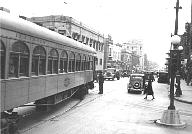
|
3. K&UT Urbana to Rantoul and Paxton Line
The Kankakee & Urbana built north from a connection to the N. Market
(Broadway) trackage in Urbana, at a point just north of the southwest end
of Cunningham Avenue, quickly turning into the line of Cunningham Ave.
and following that street northeast. Service began December 20, 1912,
and ended March 26, 1926.
After abandonment of K&UT passenger service, the ITS operated freight
service over the former K&UT tracks for grain elevators along the line.
This service was abandoned June 17, 1927, and the track was removed.
| Map 11-1. |

|
The late George Fehl drew a series of remarkable maps of the Illinois
Traction System / Illinois Terminal Railroad. Here is a composite
of the three-page map he drew of Champaign-Urbana. All tracks are
shown as of a late period in the life of the system: approximately 1930
for the city lines, about 1938 for the electrified Illinois Central and
Wabash tracks. (This map is almost 2 megabytes, and may take a while to
download.) — George Fehl, from the Paul Stringham collection |
| Map 11-2. |

|
This Fehl map shows the East Main Street trackage in Urbana.
In effect, it is an eastward extension of the previous map. Fehl
recorded every possible detail, including for example the location of each
line pole. — George Fehl |
| Maps 11-3, 11-4, and 11-5. |

|

|

|
These maps and the next two are individual pages from a remarkable
collection of maps of the Illinois Traction System in the John S. Huber
collection. They are not explicitly dated, but appear to be from the late
1920s. The trackage of the Kankakee & Urbana Traction appears to be
absent, which suggests a date of at least 1927 or 1928.
|
The central map of these three shows the interurban
trackage (but not all of the city streetcar trackage) from just west of Neil
Street to East Main Street in Urbana. The east-west track in the middle
of this map shows the entire private right-of-way between Third Street in
Champaign on the west and Main Street in Urbana on the east. The
footprints of several key University of Illinois buildings are shown near
the middle of this map. We can also see the sites of the Urbana Power
Plant and the Champaign Depot. The original Urbana Depot is seen in
ghostly form where it has been erased, with an arrow pointing to the new Urbana
Depot in the Flatiron Building. The maps do not seem to be drawn to
scale. The sidings near the new Urbana Depot and those in
the University area near Wright and Goodwin Streets seem to be next to one
another, although they were about a mile apart. Also, the curve of
East Main Street in Urbana seems to be exaggerated.
The map on the left shows the interurban tracks around the western border of
Champaign. We can see the Illinois Central branch line cutting across
the upper left corner of this map, with sidings and crossovers connecting to
the interurban tracks. Modern Duncan Road crosses these tracks north-south
immediately west of the curve in the IC tracks; that curve still crosses
Springfield Avenue in west Champaign today. Going west to east, the ITS
track makes two great swoops until on the east edge of this map, it comes into
alignment with West John Street, via which it enters Champaign. When
this area was being excavated for development in the [1980s?], the author
retrieved a rather ordinary track spike, presumably discarded when these
tracks were removed.
The map on the right shows East Main Street in Urbana from the Wabash
crossing and connection at the left, east almost to Mayview. Again, there
does not seem to be any scale to the map. The mild S-curve near the
words “1.0 Mile to Urbana” appears to represent the point at which the tracks
(looking west to east) leave the center of East Main Street and swing to the
side of the road. The “Poor Farm Siding” was located near where the
Champaign County Nursing Home is today. These details can be seen to
scale on the Fehl map, Map 11-2, above. — Collection of John S. Huber,
copyright 2011 Larry Miller Jr. and Larry Miller III |
| Maps 11-6 and 11-7. |

|

|
This pair of maps shows what the ITS called the Champaign
Belt, made up of the electrified Illinois Central and Wabash tracks
which could carry ITS traffic around the north side of the cities instead of
through their center. Initially intended for freight, it came to be used
for passenger traffic also, first in Champaign (allowing abandonment of the
West John Street trackage), and eventually in Urbana as well. In the left
map, we see at the far left edge the connection from the west, which is seen
also in Map 11-3 above. The route then follows the IC east until, at
about State Street in Champaign (the city streets are not shown), it connects
to the west end of the Wabash branch line from Sidney. We see numerous
sidings around the connections near Neil Street, including those at the
Champaign Freight House. The Belt Line continues to the east, as shown
in the right-hand map, crossing the
IC north-south main line, ultimately connecting to East Main Street in Urbana
at the lower right. Eventually, in 1937, the interurban abandoned its
city trackage in Champaign, adopting the Wabash RR depots in both Champaign
and Urbana for its passengers. Those depots are not shown on these maps.
— Collection of John S. Huber, copyright 2011 Larry Miller Jr. and Larry Miller III
|
| Map 11-8. |
| This map and the next are taken from an undated Plat Book
of Champaign Co., Illinois published by W. W. Hixson & Co. There is
a typewritten notation on the cover with a 1922 date. The actual date of
the book has to be no later than about 1914, because it shows no tracks of
the Kankakee & Urbana north of Rantoul. The K&UT tracks were
extended from Rantoul to Ludlow in late 1914.
Each page of this plat book maps one township within Champaign County.
The numbered squares are sections, 1 mile on each side. Throughout the
county, there are roads on most of the section lines. In and near
Champaign-Urbana, from west to east, the north-south roads are the modern
Duncan Rd. (between sections 9 and 10 in Champaign Twp.), Mattis Ave.,
Prospect Ave., First/Market Streets, and Lincoln Ave. (between sections 7 and 8
in Urbana Twp.). Wright Street, the boundary between the twin cities,
runs north-south through the center of Urbana Twp. sections 7 and 18.
Currently, the territories of the cities of Champaign and Urbana are separate
townships from the rural Champaign and Urbana Townships that surround them.
|

|
This map was formed by splicing together the maps of Champaign
and Urbana Townships. The boundary, at the center of the composite map,
is along First Street in Champaign, with Champaign Twp. section 12 to the left and
Urbana Twp. section 7 to the right. Most of the east-west roads line up
correctly, with the obvious exception of the diagonal line of the Cleveland
Cincinnati Chicago & St. Louis RR, which is offset a bit.
The map shows almost all of the streetcar, interurban, and steam railroad
lines in and around Champaign and Urbana, with the exception of the New Street line, part
of the Third Street track, and the in-town trackage of the Kankakee & Urbana
in northeast Urbana. No reason for the omissions is known.
|
| Map 11-9. |
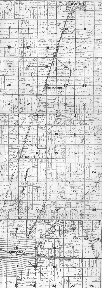
|
This map was formed from a vertical splice of the maps of
Urbana, Sommer, and Rantoul Townships. It shows the line of the
Kankakee & Urbana Traction from the Urbana city limit northward,
beginning in Urbana Twp. section 4, then turning due north along the
section line between Somer Twp. sections 27 and 28 to Thomasboro in Rantoul
Twp. section 28, then running parallel to the Illinois Central RR almost to
Rantoul, where it turns toward the northeast to enter Rantoul along the
section line road between Rantoul Twp. sections 2 and 3, which is Chandler
Street in Rantoul. The township maps north of Rantoul are not
included, because they show nothing of the K&UT. Apparently,
these maps predate the extension of the K&UT north of Rantoul in 1914.
The K&UT trackage is identified as the Joliet & Eastern Traction,
although as far as I know, the J&ET and the K&UT were never part
of the same corporate structure.
|
Go to Chapter:
[1]
[2]
[3]
[4]
[6]
[11]
[14]
[15]
[18]
Computer Science Department,
University of Illinois at Urbana-Champaign, Home Page
H. George Friedman, Jr. Home Page
Table of Contents
